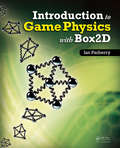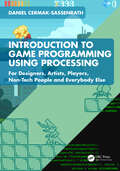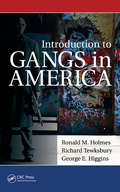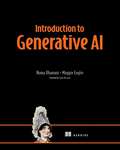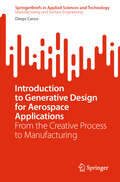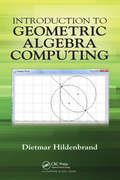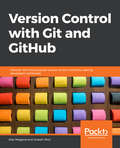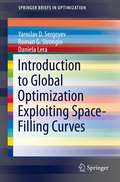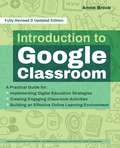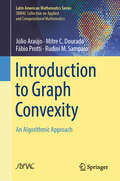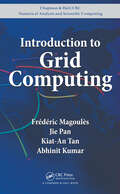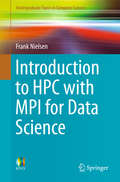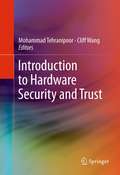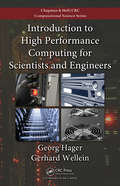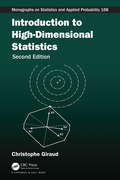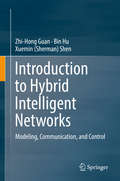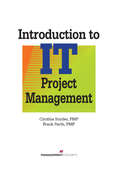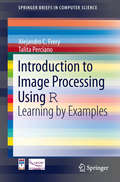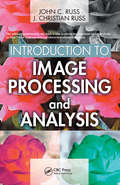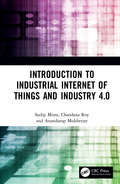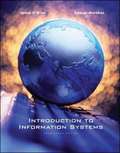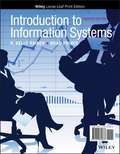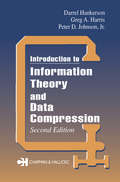- Table View
- List View
Introduction to Game Physics with Box2D
by Ian ParberryWritten by a pioneer of game development in academia, Introduction to Game Physics with Box2D covers the theory and practice of 2D game physics in a relaxed and entertaining yet instructional style. It offers a cohesive treatment of the topics and code involved in programming the physics for 2D video games. Focusing on writing elementary game physics code, the first half of the book helps you grasp the challenges of programming game physics from scratch, without libraries or outside help. It examines the mathematical foundation of game physics and illustrates how it is applied in practice through coding examples. The second half of the book shows you how to use Box2D, a popular open source 2D game physics engine. A companion website provides supplementary material, including source code and videos. This book helps you become a capable 2D game physics programmer through its presentation of both the theory and applications of 2D game physics. After reading the book and experimenting with the code samples, you will understand the basics of 2D game physics and know how to use Box2D to make a 2D physics-based game.
Introduction to Game Programming using Processing: For Designers, Artists, Players, Non-Tech People and Everybody Else
by Daniel Cermak-SassenrathThis is an introductory textbook focusing on games (specifically interaction and graphics) as a pathway into programming. It empowers readers to do basic programming, prototyping, game creation, and other highly interactive applications, all from scratch and without any prior programming knowledge.Using the popular programming language Processing, this book describes, explains, and demonstrates the basic and general programming principles and mechanisms used in typical game algorithms and concrete game projects. Chapters cover basic graphics, text output, loops, data types and variables, movement, time, audio and sound, debugging, classes and objects, event-based programming, real-time input controls, computer speed compensation, animation, tiling, scrolling, collision detection, basic AI, and much more. Additional support materials such as code examples and demo programs are available to download from this book’s webpage.This book is a great resource for students and aspiring professionals looking for an approachable entry into game programming.
Introduction to Gangs in America
by Richard Tewksbury Ronald M. Holmes George HigginsGangs have long been a social and criminal threat to society. Introduction to Gangs in America explains how gangs are addressed as a criminal justice and public policy problem, providing a student-friendly, easily accessible, concise overview of the role, place, structure, and activities of gangs in American society. The book describes what gangs a
Introduction to Generative AI
by Numa DhamaniGenerative AI tools like ChatGPT are amazing—but how will their use impact our society? This book introduces the world-transforming technology and the strategies you need to use generative AI safely and effectively.Introduction to Generative AI gives you the hows-and-whys of generative AI in accessible language. In this easy-to-read introduction, you&’ll learn: How large language models (LLMs) work How to integrate generative AI into your personal and professional workflows Balancing innovation and responsibility The social, legal, and policy landscape around generative AI Societal impacts of generative AI Where AI is going Anyone who uses ChatGPT for even a few minutes can tell that it&’s truly different from other chatbots or question-and-answer tools. Introduction to Generative AI guides you from that first eye-opening interaction to how these powerful tools can transform your personal and professional life. In it, you&’ll get no-nonsense guidance on generative AI fundamentals to help you understand what these models are (and aren&’t) capable of, and how you can use them to your greatest advantage. Foreword by Sahar Massachi. About the technology Generative AI tools like ChatGPT, Bing, and Bard have permanently transformed the way we work, learn, and communicate. This delightful book shows you exactly how Generative AI works in plain, jargon-free English, along with the insights you&’ll need to use it safely and effectively. About the book Introduction to Generative AI guides you through benefits, risks, and limitations of Generative AI technology. You&’ll discover how AI models learn and think, explore best practices for creating text and graphics, and consider the impact of AI on society, the economy, and the law. Along the way, you&’ll practice strategies for getting accurate responses and even understand how to handle misuse and security threats. What's inside How large language models work Integrate Generative AI into your daily work Balance innovation and responsibility About the reader For anyone interested in Generative AI. No technical experience required. About the author Numa Dhamani is a natural language processing expert working at the intersection of technology and society. Maggie Engler is an engineer and researcher currently working on safety for large language models. The technical editor on this book was Maris Sekar. Table of Contents 1 Large language models: The power of AI Evolution of natural language processing 2 Training large language models 3 Data privacy and safety with LLMs 4 The evolution of created content 5 Misuse and adversarial attacks 6 Accelerating productivity: Machine-augmented work 7 Making social connections with chatbots 8 What&’s next for AI and LLMs 9 Broadening the horizon: Exploratory topics in AI
Introduction to Generative Design for Aerospace Applications: From the Creative Process to Manufacturing (SpringerBriefs in Applied Sciences and Technology)
by Diego CarouThis book provides a comprehensive introduction to generative design in the aerospace sector, guiding readers from initial creative concepts to the final stages of manufacturing. It offers a thorough exploration of sustainable production methods, cutting-edge technological advancements, and the principles of generative design. With a focus on artificial intelligence's role in optimizing design and manufacturing, this book also delves into topology optimization, offering valuable insights for both newcomers and experienced professionals in the field. Through practical examples and a structured approach, readers will gain a solid understanding of the innovations shaping the future of aerospace design.
Introduction to Geometric Algebra Computing: Computing with Circles and Lines (Computer Vision Series)
by Dietmar HildenbrandFrom the Foreword: "Dietmar Hildenbrand's new book, Introduction to Geometric Algebra Computing, in my view, fills an important gap in Clifford's geometric algebra literature…I can only congratulate the author for the daring simplicity of his novel educational approach taken in this book, consequently combined with hands on computer based exploration. Without noticing, the active reader will thus educate himself in elementary geometric algebra algorithm development, geometrically intuitive, highly comprehensible, and fully optimized." --Eckhard Hitzer, International Christian University, Tokyo, Japan Geometric Algebra is a very powerful mathematical system for an easy and intuitive treatment of geometry, but the community working with it is still very small. The main goal of this book is to close this gap with an introduction to Geometric Algebra from an engineering/computing perspective. This book is intended to give a rapid introduction to computing with Geometric Algebra and its power for geometric modeling. From the geometric objects point of view, it focuses on the most basic ones, namely points, lines and circles. This algebra is called Compass Ruler Algebra, since it is comparable to working with a compass and ruler. The book explores how to compute with these geometric objects, and their geometric operations and transformations, in a very intuitive way. The book follows a top-down approach, and while it focuses on 2D, it is also easily expandable to 3D computations. Algebra in engineering applications such as computer graphics, computer vision and robotics are also covered.
Introduction to Git and GitHub
by Joseph Muli Alex MaganaIf you want to migrate from other version control tools or want to learn more about Git, you will find this course useful and interesting. Prior experience in coding or familiarity with using the bash command line interface, will enable you to easily grasp concepts.
Introduction to Global Optimization Exploiting Space-Filling Curves
by Yaroslav D. Sergeyev Daniela Lera Roman G. StronginIntroduction to Global Optimization Exploiting Space-Filling Curves provides an overview of classical and new results pertaining to the usage of space-filling curves in global optimization. The authors look at a family of derivative-free numerical algorithms applying space-filling curves to reduce the dimensionality of the global optimization problem; along with a number of unconventional ideas, such as adaptive strategies for estimating Lipschitz constant, balancing global and local information to accelerate the search. Convergence conditions of the described algorithms are studied in depth and theoretical considerations are illustrated through numerical examples. This work also contains a code for implementing space-filling curves that can be used for constructing new global optimization algorithms. Basic ideas from this text can be applied to a number of problems including problems with multiextremal and partially defined constraints and non-redundant parallel computations can be organized. Professors, students, researchers, engineers, and other professionals in the fields of pure mathematics, nonlinear sciences studying fractals, operations research, management science, industrial and applied mathematics, computer science, engineering, economics, and the environmental sciences will find this title useful .
Introduction to Google Classroom
by Annie BrockLearn to take your classroom curriculum digital using Google Classroom&’s unique file sharing features. Introduction to Google Classroom will help teachers of all grade levels master the basics of communication and education using the Google Classroom file sharing service. Learn how to connect with students, control access to lessons, distribute assignments, and update your class calendar. Google Classroom newbie? No worries! Experienced educator and author Annie Brock takes readers step-by-step through the most common Google Classroom features and terminology. Packed with tips, tricks, troubleshooting, helpful screenshots, and activity ideas to keep students of all ages engaged, this book is indispensable as the future of teaching continues to evolve.
Introduction to Graph Convexity: An Algorithmic Approach (Latin American Mathematics Series)
by Júlio Araújo Mitre C. Dourado Fábio Protti Rudini M. SampaioThis book focuses on the computational aspects of graph convexity, with a particular emphasis on path convexity within graphs. It provides a thoughtful introduction to this emerging research field, which originated by adapting concepts from convex geometry to combinatorics and has experienced substantial growth. The book starts with an introduction of fundamental convexity concepts and then proceeds to discuss convexity parameters. These parameters fall into two categories: one derived from abstract convexity studies and another motivated by computational complexity. Subsequent chapters explore geometric convexity within graphs, examining various graph classes such as interval graphs, proper interval graphs, cographs, chordal graphs, and strongly chordal graphs. The text concludes with a study of the computation of convexity parameters across different convexity types, including practical applications in areas like game theory. Compact and straightforward, this work serves as an ideal entry point for students and researchers interested in pursuing further research in the field of convexity. The English translation of this book, originally in Portuguese, was facilitated by artificial intelligence. The content was later revised by the authors for accuracy.
Introduction to Grid Computing (Chapman & Hall/CRC Numerical Analysis and Scientific Computing Series)
by Frederic Magoules Jie Pan Kiat-An Tan Abhinit KumarA Thorough Overview of the Next Generation in ComputingPoised to follow in the footsteps of the Internet, grid computing is on the verge of becoming more robust and accessible to the public in the near future. Focusing on this novel, yet already powerful, technology, Introduction to Grid Computing explores state-of-the-art grid projects, core grid
Introduction to HPC with MPI for Data Science
by Frank NielsenThis gentle introduction to High Performance Computing (HPC) for Data Science using the Message Passing Interface (MPI) standard has been designed as a first course for undergraduates on parallel programming on distributed memory models, and requires only basic programming notions. Divided into two parts the first part covers high performance computing using C++ with the Message Passing Interface (MPI) standard followed by a second part providing high-performance data analytics on computer clusters. In the first part, the fundamental notions of blocking versus non-blocking point-to-point communications, global communications (like broadcast or scatter) and collaborative computations (reduce), with Amdalh and Gustafson speed-up laws are described before addressing parallel sorting and parallel linear algebra on computer clusters. The common ring, torus and hypercube topologies of clusters are then explained and global communication procedures on these topologies are studied. This first part closes with the MapReduce (MR) model of computation well-suited to processing big data using the MPI framework. In the second part, the book focuses on high-performance data analytics. Flat and hierarchical clustering algorithms are introduced for data exploration along with how to program these algorithms on computer clusters, followed by machine learning classification, and an introduction to graph analytics. This part closes with a concise introduction to data core-sets that let big data problems be amenable to tiny data problems. Exercises are included at the end of each chapter in order for students to practice the concepts learned, and a final section contains an overall exam which allows them to evaluate how well they have assimilated the material covered in the book.
Introduction to Hardware Security and Trust
by Cliff Wang Mohammad TehranipoorThis book provides the foundations for understanding hardware security and trust, which have become major concerns for national security over the past decade. Coverage includes security and trust issues in all types of electronic devices and systems such as ASICs, COTS, FPGAs, microprocessors/DSPs, and embedded systems. This serves as an invaluable reference to the state-of-the-art research that is of critical significance to the security of, and trust in, modern society's microelectronic-supported infrastructures.
Introduction to High Performance Computing for Scientists and Engineers (Chapman & Hall/CRC Computational Science)
by Georg Hager Gerhard WelleinWritten by high performance computing (HPC) experts, Introduction to High Performance Computing for Scientists and Engineers provides a solid introduction to current mainstream computer architecture, dominant parallel programming models, and useful optimization strategies for scientific HPC. From working in a scientific computing center, the author
Introduction to High-Dimensional Statistics (Chapman & Hall/CRC Monographs on Statistics and Applied Probability #138)
by Christophe GiraudPraise for the first edition: "[This book] succeeds singularly at providing a structured introduction to this active field of research. … it is arguably the most accessible overview yet published of the mathematical ideas and principles that one needs to master to enter the field of high-dimensional statistics. … recommended to anyone interested in the main results of current research in high-dimensional statistics as well as anyone interested in acquiring the core mathematical skills to enter this area of research."—Journal of the American Statistical Association Introduction to High-Dimensional Statistics, Second Edition preserves the philosophy of the first edition: to be a concise guide for students and researchers discovering the area and interested in the mathematics involved. The main concepts and ideas are presented in simple settings, avoiding thereby unessential technicalities. High-dimensional statistics is a fast-evolving field, and much progress has been made on a large variety of topics, providing new insights and methods. Offering a succinct presentation of the mathematical foundations of high-dimensional statistics, this new edition: Offers revised chapters from the previous edition, with the inclusion of many additional materials on some important topics, including compress sensing, estimation with convex constraints, the slope estimator, simultaneously low-rank and row-sparse linear regression, or aggregation of a continuous set of estimators. Introduces three new chapters on iterative algorithms, clustering, and minimax lower bounds. Provides enhanced appendices, minimax lower-bounds mainly with the addition of the Davis-Kahan perturbation bound and of two simple versions of the Hanson-Wright concentration inequality. Covers cutting-edge statistical methods including model selection, sparsity and the Lasso, iterative hard thresholding, aggregation, support vector machines, and learning theory. Provides detailed exercises at the end of every chapter with collaborative solutions on a wiki site. Illustrates concepts with simple but clear practical examples.
Introduction to Hybrid Intelligent Networks: Modeling, Communication, and Control
by Bin Hu Xuemin Sherman Shen Zhi-Hong GuanThis book covers the fundamental principles, new theories and methodologies, and potential applications of hybrid intelligent networks. Chapters focus on hybrid neural networks and networked multi-agent networks, including their communication, control and optimization synthesis. This text also provides a succinct but useful guideline for designing neural network-based hybrid artificial intelligence for brain-inspired computation systems and applications in the Internet of Things.Artificial Intelligence has developed into a deep research field targeting robots with more brain-inspired perception, learning, decision-making abilities, etc. This text devoted to a tutorial on hybrid intelligent networks that have been identified in nature and engineering, especially in the brain, modeled by hybrid dynamical systems and complex networks, and have shown potential application to brain-inspired intelligence. Included in this text are impulsive neural networks, neurodynamics, multiagent networks, hybrid dynamics analysis, collective dynamics, as well as hybrid communication, control and optimization methods. Graduate students who are interested in artificial intelligence and hybrid intelligence, as well as professors and graduate students who are interested in neural networks and multiagent networks will find this textbook a valuable resource. AI engineers and consultants who are working in wireless communications and networking will want to buy this book. Also, professional and academic institutions in universities and Mobile vehicle companies and engineers and managers who concern humans in the loop of IoT will also be interested in this book.
Introduction to IT Project Management
by Cynthia Snyder PMP Frank Parth PMPIntroduction to IT Project Management provides IT project managers the practical tools needed to maintain daily operations while managing multiple projects. This valuable reference helps IT project managers, CIOs, and project sponsors understand the IT project environment so that projects can be managed much more efficiently and successfully. An instructor's guide is available.
Introduction to Image Processing Using R
by Alejandro C. Frery Talita PercianoThis book introduces the statistical software R to the image processing community in an intuitive and practical manner. R brings interesting statistical and graphical tools which are important and necessary for image processing techniques. Furthermore, it has been proved in the literature that R is among the most reliable, accurate and portable statistical software available. Both the theory and practice of R code concepts and techniques are presented and explained, and the reader is encouraged to try their own implementation to develop faster, optimized programs. Those who are new to the field of image processing and to R software will find this work a useful introduction. By reading the book alongside an active R session, the reader will experience an exciting journey of learning and programming.
Introduction to Image Processing and Analysis
by John C. Russ J. Christian Russ<p>Image processing comprises a broad variety of methods that operate on images to produce another image. A unique textbook, Introduction to Image Processing and Analysis establishes the programming involved in image processing and analysis by utilizing skills in C compiler and both Windows and MacOS programming environments. The provided mathematical background illustrates the workings of algorithms and emphasizes the practical reasons for using certain methods, their effects on images, and their appropriate applications. The text concentrates on image processing and measurement and details the implementation of many of the most widely used and most important image processing and analysis algorithms. <p>Homework problems are included in every chapter with solutions available for download from the CRC Press website. The chapters work together to combine image processing with image analysis. The book begins with an explanation of familiar pixel array and goes on to describe the use of frequency space. Chapters 1 and 2 deal with the algorithms used in processing steps that are usually accomplished by a combination of measurement and processing operations, as described in chapters 3 and 4. The authors present each concept using a mixture of three mutually supportive tools: a description of the procedure with example images, the relevant mathematical equations behind each concept, and the simple source code (in C), which illustrates basic operations. In particularly, the source code provides a starting point to develop further modifications. <p>Written by John Russ, author of esteemed Image Processing Handbook now in its fifth edition, this book demonstrates functions to improve an image's of features and detail visibility, improve images for printing or transmission, and facilitate subsequent analysis.</p>
Introduction to Industrial Internet of Things and Industry 4.0
by Sudip Misra Chandana Roy Anandarup MukherjeeIndustrial IoT (IIoT) and Industry 4.0 are newly developing and fast emerging domains of interest among students, researchers, and professionals in academia and industry. Due to the popular demand of this topic, Introduction to Industrial Internet of Things and Industry 4.0 is written to serve a diverse readership from the domains of computer science and engineering, mechanical engineering, information technology, industrial engineering, electronics engineering, and other related branches of engineering. Based on the lead author’s massive open online courses (MOOCs), this book can be used as a textbook on the emerging paradigm of Industry 4.0 and IIoT, as well as a reference for professionals working in sectors of IIoT. The book covers the significant aspects of IIoT in detail, including sensors, actuators, data transmission, and data acquisition, which form the core of IIoT. Topics and concepts are presented in a comprehensive manner, so that readers can develop expertise and knowledge. The book helps beginners to gain a basic idea of Industry 4.0 and IIoT as the first section is an overview of IoT applications, infrastructure-based protocols, cloud computing, and fog computing. The second section is designed to impart a basic knowledge of Industry 4.0 and IIoT as well as of the different phases of development in industry. Delving into more advanced areas, other sections in the book cover: The business models and reference architecture of IIoT The technological aspects of Industry 4.0 and IIoT Predictive and prescriptive analytics applied in IIoT-based implementations Applications and case studies of IIoT Key enabling technologies of IIoT To aid students and professional master IIoT and Industry 4.0, the book includes conceptual questions, exercises, and learning objectives.
Introduction to Information Retrieval
by Christopher D. Manning Prabhakar Raghavan Hinrich SchützeClass-tested and coherent, this groundbreaking new textbook teaches web-era information retrieval, including web search and the related areas of text classification and text clustering from basic concepts. Written from a computer science perspective by three leading experts in the field, it gives an up-to-date treatment of all aspects of the design and implementation of systems for gathering, indexing, and searching documents; methods for evaluating systems; and an introduction to the use of machine learning methods on text collections. All the important ideas are explained using examples and figures, making it perfect for introductory courses in information retrieval for advanced undergraduates and graduate students in computer science. Based on feedback from extensive classroom experience, the book has been carefully structured in order to make teaching more natural and effective. Although originally designed as the primary text for a graduate or advanced undergraduate course in information retrieval, the book will also create a buzz for researchers and professionals alike.
Introduction to Information Systems (14th edition)
by James A. O'Brien George M. MarakasO'Brien's Introduction to Information Systems 14e continues to reflect the movement toward enterprise-wide business applications. George Marakas from the University of Kansas joins as a co-author on this new edition. New real world case studies correspond with this curriculum shift. The texts focus is on teaching the general business manager how to use and manage the most current IT technologies such as the Internet, Intranets, and Extranets for enterprise collaboration, and how IT contributes to competitive advantage, re-engineering business processes, problem solving, and decision-making.
Introduction to Information Systems for Health Information Technology
by Nanette B. Sayles Lauralyn Kavanaugh-BurkeIntroduction to Computers in Health, Information Management, Information Integrity and Data Quality, Databases System Selection, System Implementation Computers in HIM, Administrative Information Systems, Clinical Information Systems, Electronic Health Record, Consumer Informatics, Health Information Exchange, Standards, Security, Information and Data Governance, Role of HIM, Professionals in Information Systems.
Introduction to Information Systems: Seventh Edition
by R. Kelly Rainer Casey G. CegielskiThe goal of Introduction to Information Systems is to teach undergraduate business majors how to use information technology to master their current or future jobs. Students develop a working understanding of information systems and information technology and learn how to apply concepts to successfully facilitate business processes. This product demonstrates that IT is a key component of any business, whether a student is majoring in Accounting, Finance, Marketing, Human Resources, or Production/Operations Management.
Introduction to Information Theory and Data Compression (Applied Mathematics)
by Peter D. Johnson Jr. Greg A. Harris D.C. HankersonAn effective blend of carefully explained theory and practical applications, this text imparts the fundamentals of both information theory and data compression. Although the two topics are related, this unique text allows either topic to be presented independently, and it was specifically designed so that the data compression section requires no pr
